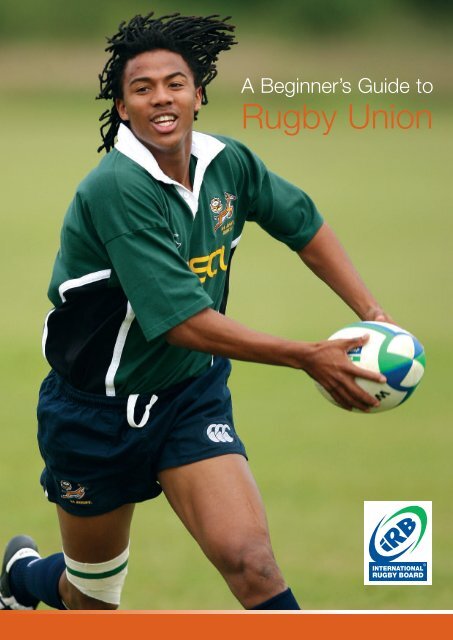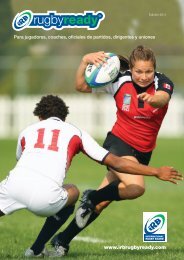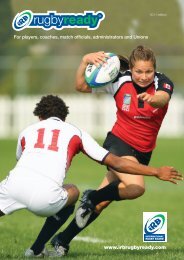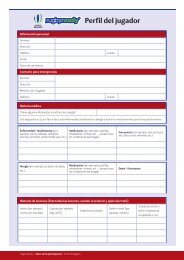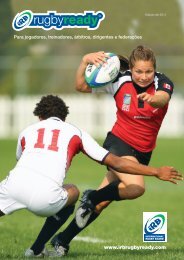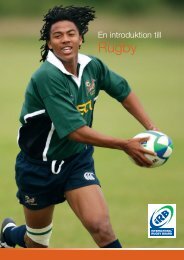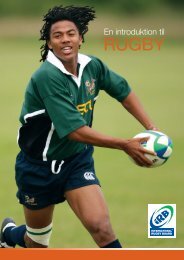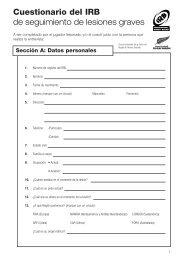A Beginner's Guide to Rugby Union - IRB Rugby Ready
A Beginner's Guide to Rugby Union - IRB Rugby Ready
A Beginner's Guide to Rugby Union - IRB Rugby Ready
You also want an ePaper? Increase the reach of your titles
YUMPU automatically turns print PDFs into web optimized ePapers that Google loves.
A Beginner’s <strong>Guide</strong> <strong>to</strong><br />
<strong>Rugby</strong> <strong>Union</strong>
Safety<br />
as a <strong>to</strong>p priority<br />
<strong>Rugby</strong> is a highly physical<br />
Game. To enjoy it <strong>to</strong> its<br />
utmost you need <strong>to</strong> be<br />
physically and mentally<br />
prepared. You also need <strong>to</strong><br />
understand how <strong>to</strong> play<br />
safely.<br />
www.irbrugbyready.com<br />
The <strong>IRB</strong> <strong>Rugby</strong> <strong>Ready</strong><br />
programme educates, aids<br />
and supports players,<br />
coaches, match officials and<br />
<strong>Union</strong>s on the importance of<br />
sufficient preparation for<br />
training and playing in order<br />
for <strong>Rugby</strong> <strong>to</strong> be played and<br />
enjoyed while reducing the<br />
risk of serious injury.<br />
The web site allows you <strong>to</strong><br />
read material, watch video,<br />
complete an on-line self<br />
check test and generate an<br />
awareness certificate. Or<br />
contact your national <strong>Union</strong><br />
for details of face-<strong>to</strong>-face<br />
courses near you.<br />
Disclaimer<br />
This <strong>IRB</strong> Beginner’s <strong>Guide</strong> <strong>to</strong> <strong>Rugby</strong> <strong>Union</strong><br />
product has been developed in the context<br />
of the Laws applying <strong>to</strong> accident and injury<br />
prevention and medical practice in Ireland<br />
and the information and guidelines<br />
incorporated on these matters are made<br />
available strictly on the basis that the <strong>IRB</strong><br />
(including its operating entity IRFB<br />
Services (Ireland) Limited and other<br />
associated entities) does not accept any<br />
liability <strong>to</strong> any person or entity for loss,<br />
cost or damage howsoever arising out of<br />
any reliance on and/or use of the<br />
information and/or guidelines contained in<br />
this <strong>IRB</strong> Beginner’s <strong>Guide</strong> <strong>to</strong> <strong>Rugby</strong><br />
<strong>Union</strong> product.<br />
2<br />
Images courtesy of World <strong>Rugby</strong> Museum, Twickenham and Getty Images<br />
<strong>Rugby</strong>’s his<strong>to</strong>ry & ethos<br />
The <strong>IRB</strong> Playing Charter<br />
The International <strong>Rugby</strong> Board<br />
publishes a Playing Charter setting<br />
out <strong>Rugby</strong>’s basic principles:<br />
conduct, spirit, controlled physicality<br />
and contest for possession. The<br />
Charter’s objective is <strong>to</strong> ensure that<br />
<strong>Rugby</strong> maintains its unique character<br />
both on and off the field.<br />
Legend has it that in 1823,<br />
during a game of school<br />
football in the <strong>to</strong>wn of <strong>Rugby</strong>,<br />
England, a young man named<br />
William Webb Ellis picked up<br />
the ball and ran <strong>to</strong>wards the<br />
opposition’s goal line.<br />
Two centuries later, <strong>Rugby</strong><br />
Football has evolved in<strong>to</strong> one of<br />
the world’s most popular sports,<br />
with millions of people playing,<br />
watching and enjoying the Game.<br />
At the heart of <strong>Rugby</strong> is a unique<br />
ethos which it has retained over<br />
the years. Not only is the Game<br />
played <strong>to</strong> the Laws, but within<br />
the spirit of the Laws.<br />
Through discipline, control and<br />
mutual self-respect, a fellowship<br />
and sense of fair play are forged,<br />
defining <strong>Rugby</strong> as the Game it is.<br />
From the school playground <strong>to</strong><br />
the <strong>Rugby</strong> World Cup final, <strong>Rugby</strong><br />
<strong>Union</strong> offers a truly unique and<br />
thoroughly rewarding experience<br />
for all involved in the Game.<br />
The principles of <strong>Rugby</strong> are the fundamental elements upon which the<br />
Game is based and they enable participants immediately <strong>to</strong> identify the<br />
character of the Game and what makes it distinctive as a sport which is<br />
played by people of all shapes and sizes.<br />
The <strong>IRB</strong> Playing Charter is incorporated within the <strong>IRB</strong> Laws of the Game<br />
and can be downloaded from www.irb.com in English, French, Spanish,<br />
Russian, Traditional Chinese, Japanese and Italian.
The Game<br />
<strong>Rugby</strong> is a game in which the object is <strong>to</strong> carry the ball over the<br />
opponents’ goal line and force it <strong>to</strong> the ground <strong>to</strong> score.<br />
It’s simple... but complex<br />
The above description may sound simple - but there is one catch. In<br />
order <strong>to</strong> go forward, the ball must be passed backwards. The ball can be<br />
kicked forwards, but the kicker’s team mates must be behind the ball at<br />
the moment the ball is kicked.<br />
This apparent contradiction creates a need for fine teamwork and great<br />
discipline, as little can be achieved by any one individual player. Only by<br />
working as a team can players move the ball forward <strong>to</strong>wards their<br />
opponents’ goal line and eventually go on <strong>to</strong> win the game.<br />
The field of play<br />
Touch-in-goal<br />
Touchline<br />
Touch Touch Touch-<br />
in-goal<br />
5m<br />
Touch-ingoal<br />
line<br />
Touch-ingoal<br />
line<br />
15m<br />
<strong>Rugby</strong> has its unique aspects, but like<br />
many other sports it is essentially about<br />
the creation and use of space. The<br />
winners of a game of <strong>Rugby</strong> will be the<br />
team of players who can get themselves<br />
and the ball in<strong>to</strong> space and use that<br />
space wisely, while denying the opposing<br />
team both possession of the ball and<br />
access <strong>to</strong> space in which <strong>to</strong> use it.<br />
Dead ball line<br />
In-goal In-goal<br />
5m<br />
Goal line<br />
22-metre line<br />
10-metre line<br />
Half way line<br />
10-metre line<br />
22-metre line<br />
Goal line<br />
In-goal<br />
Not exceeding 70m<br />
Dead ball line<br />
10m<br />
22m<br />
Not exceeding<br />
22m<br />
Not exceeding 100m<br />
Not exceeding 22m<br />
A Beginner’s <strong>Guide</strong> <strong>to</strong> <strong>Rugby</strong> <strong>Union</strong><br />
Scoring points<br />
Try - 5 points<br />
A try is scored<br />
when the ball is<br />
grounded over<br />
the opponents’<br />
goal line in the<br />
in-goal area.<br />
A penalty try can<br />
be awarded if a<br />
player would<br />
have scored a try<br />
but for foul play<br />
by the opposition.<br />
Try signal<br />
Conversion - 2 points<br />
After scoring a try, that team<br />
can attempt <strong>to</strong> add two<br />
further points by kicking the<br />
ball over the crossbar and<br />
between the posts from a<br />
place in line with where the<br />
try was scored.<br />
Penalty - 3 points<br />
When awarded a penalty<br />
after an infringement by the<br />
opposition, a team may<br />
choose <strong>to</strong> kick at goal.<br />
Drop goal - 3 points<br />
A drop goal is scored when<br />
a player kicks for goal in<br />
open play by dropping the<br />
ball on<strong>to</strong> the ground and<br />
kicking it on the half-volley.<br />
3
Kicking<br />
If a player chooses not <strong>to</strong><br />
pass the ball <strong>to</strong> a team mate<br />
or run with it, that player<br />
may kick the ball instead.<br />
The kick can travel forwards,<br />
but any team mates in front<br />
of the ball at the moment the<br />
ball is kicked are out of play<br />
until either they retire behind<br />
the kicker or are played<br />
onside by a team mate.<br />
Retaining possession of the<br />
ball following a kick is a<br />
challenge. Kicking strategies<br />
include:<br />
• kicking in<strong>to</strong> space, so that<br />
team mates have time <strong>to</strong><br />
run on<strong>to</strong> the ball before an<br />
opponent can get <strong>to</strong> it<br />
• kicking out wide, at an<br />
oblique angle <strong>to</strong> the field,<br />
so that the wing or outside<br />
centre can catch the ball<br />
• kicking the ball <strong>to</strong> <strong>to</strong>uch<br />
(off the field of play)<br />
resulting in a lineout (see<br />
page 9) with the throw-in<br />
<strong>to</strong> the opposition. This<br />
concedes possession of<br />
the ball but allows the<br />
kicking team <strong>to</strong> contest for<br />
the ball in a much more<br />
advantageous position on<br />
the field.<br />
4<br />
Open play<br />
The term ‘open play’ refers <strong>to</strong> any phase in the match where the ball<br />
is being passed or kicked between team mates and both teams are<br />
contesting for the ball. In open play, the team in possession tries <strong>to</strong><br />
get the ball <strong>to</strong> players in space who can make forward progress<br />
<strong>to</strong>wards the opposing goal line.<br />
Kick off<br />
Each half of the match is started<br />
with a drop kick from the centre<br />
of the half way line. The nonkicking<br />
team must be 10 metres<br />
back from the ball when it is<br />
kicked and the kick must travel<br />
10m <strong>to</strong>wards the opposition goal<br />
line before hitting the ground.<br />
Handling<br />
Passing<br />
A player may pass (throw the<br />
ball) <strong>to</strong> a team mate who is in a<br />
better position <strong>to</strong> continue the<br />
attack, but the pass must not<br />
travel <strong>to</strong>wards the opposing<br />
team’s goal line. It must travel<br />
either directly across the field, or<br />
back in the direction of the<br />
passer’s own goal line.<br />
By carrying the ball forwards and<br />
passing backwards, terri<strong>to</strong>ry is<br />
gained.<br />
If a forward pass is made, the referee will s<strong>to</strong>p the game and award a<br />
scrum (see page 8) with the throw-in going <strong>to</strong> the team which was not in<br />
possession at the time of the pass. In this way, a forward pass is<br />
punished by that team losing possession of the ball.<br />
Knock-on<br />
When a player mishandles the<br />
ball, i.e. drops it or allows it <strong>to</strong><br />
rebound off a hand or arm, and<br />
the ball travels forwards, it is<br />
known as a knock-on.<br />
This is punishable by a scrum <strong>to</strong><br />
the opposition and therefore a<br />
turnover of possession.
Tackle, ruck & maul<br />
As well as being an evasion game which requires creation and use<br />
of space, <strong>Rugby</strong> is also a contact sport. In fact, contact situations<br />
can be the very mechanism by which players create the space they<br />
need <strong>to</strong> attack. The three most common contact situations which<br />
occur in open play are tackle, ruck and maul.<br />
The tackle<br />
Only the ball carrier can be<br />
tackled by an opposing player.<br />
A tackle occurs when the ball<br />
carrier is held by one or more<br />
opponents and is brought <strong>to</strong><br />
ground, i.e. has one or both knees<br />
on the ground, is sitting on the<br />
ground or is on <strong>to</strong>p of another<br />
player who is on the ground. To<br />
maintain the continuity of the<br />
game, the ball carrier must release the ball immediately after the tackle,<br />
the tackler must release the ball carrier and both players must roll away<br />
from the ball. This allows other players <strong>to</strong> come in and contest for the<br />
ball, thereby starting a new phase of play.<br />
The ruck<br />
The maul<br />
A maul occurs when the ball<br />
carrier is held by one or more<br />
opponents and one or more of the<br />
ball carrier’s team mates holds on<br />
(binds) on as well. The ball must<br />
be off the ground.<br />
A ruck is formed if the ball is on<br />
the ground and one or more<br />
players from each team who are<br />
on their feet close around it.<br />
Players must not handle the ball<br />
in the ruck, and must use their<br />
feet <strong>to</strong> move the ball or drive<br />
over it so that it emerges at the<br />
team’s hindmost foot, at which<br />
point it can be picked up.<br />
The team in possession of the ball can attempt <strong>to</strong> gain terri<strong>to</strong>ry by driving<br />
their opponents back <strong>to</strong>wards the opponents’ goal line. The ball can then<br />
be passed backwards between players in the maul and eventually<br />
passed <strong>to</strong> a player who is not in the maul, or a player can leave the maul<br />
carrying the ball and run with it.<br />
A Beginner’s <strong>Guide</strong> <strong>to</strong> <strong>Rugby</strong> <strong>Union</strong><br />
Advantage<br />
The advantage Law allows<br />
the game <strong>to</strong> be more<br />
continuous and have fewer<br />
s<strong>to</strong>ppages.<br />
Sometimes, during a game,<br />
an infringement of the Laws<br />
may be committed where a<br />
s<strong>to</strong>ppage in play would<br />
deprive the non-offending<br />
team of an opportunity <strong>to</strong><br />
score.<br />
Even though the Laws state<br />
that the non-offending team<br />
should be awarded a penalty,<br />
free kick or scrum, they are<br />
given the opportunity <strong>to</strong><br />
continue with open play and<br />
attempt <strong>to</strong> score a try.<br />
In this instance, the referee<br />
will allow play <strong>to</strong> continue<br />
rather than penalise the<br />
offence.<br />
Offside<br />
<strong>Rugby</strong>’s offside Law restricts<br />
where on the field players<br />
can be, <strong>to</strong> ensure there is<br />
space <strong>to</strong> attack and defend.<br />
In general, a player is in an<br />
offside position if that player<br />
is further forward (nearer <strong>to</strong><br />
the opponents’ goal line) than<br />
the team mate who is<br />
carrying the ball or the team<br />
mate who last played the ball.<br />
Being in an offside position<br />
is not, in itself, an offence,<br />
but an offside player may<br />
not take part in the game<br />
until they are onside again.<br />
If an offside player takes<br />
part in the game, that player<br />
will be penalised.<br />
5
The positions<br />
<strong>Rugby</strong> <strong>Union</strong> has always been<br />
characterised by the notion<br />
that it is a game for all shapes<br />
and sizes.<br />
Uniquely, each position<br />
requires a different set of<br />
physical and technical<br />
attributes and it is this diversity<br />
which makes the game so<br />
accessible <strong>to</strong> all.<br />
From the power of the<br />
forwards <strong>to</strong> the speed of the<br />
backs, there’s a place in a<br />
<strong>Rugby</strong> team for anyone who<br />
wants a slice of the action.<br />
6<br />
Locks<br />
Props<br />
4 5<br />
Forwards<br />
Backs<br />
1 3<br />
What they do: Their primary role is <strong>to</strong> anchor the<br />
scrummage and provide lifting strength and support<br />
for the lineout jumpers. Also pivotal in rucks & mauls.<br />
What they need: Upper-body strength <strong>to</strong> provide<br />
stability in the scrum, endurance, mobility and safe<br />
hands <strong>to</strong> maintain continuity of play.<br />
11<br />
Left<br />
wing<br />
What they do: Locks win ball from lineouts and<br />
restarts. They drive forward momentum in the scrum,<br />
rucks and mauls providing a platform for attack.<br />
What they need: The key characteristic is height. The<br />
locks are the giants of the team and combine their<br />
physicality with great catching skills and mobility.<br />
13<br />
Outside<br />
centre<br />
12<br />
Loose-head<br />
prop<br />
Lock<br />
Open-side<br />
flanker<br />
Inside centre<br />
15<br />
10<br />
Fly half<br />
Full back<br />
Hooker<br />
Number 8<br />
9<br />
Scrum half<br />
Tight-head<br />
prop<br />
Lock<br />
Blind-side<br />
flanker<br />
The names of positions given here are the most commonly used across the <strong>Rugby</strong> world.<br />
However, some regional variations may exist.<br />
Hooker<br />
Flankers<br />
2<br />
6 7<br />
14<br />
Right<br />
wing<br />
What they do: The hooker has two unique roles on<br />
the pitch as the player who wins possession in the<br />
scrum and usually throws the ball in <strong>to</strong> the lineout.<br />
What they need: Great strength <strong>to</strong> withstand the<br />
physicality of the front row coupled with speed <strong>to</strong> get<br />
around the pitch and good throwing technique.<br />
What they do: Their key objective is <strong>to</strong> win possession<br />
through turn-overs, using physicality in the tackle and<br />
speed <strong>to</strong> the breakdown.<br />
What they need: An insatiable desire for big tackles and<br />
a no-fear approach <strong>to</strong> winning the ball. A combination of<br />
speed, strength, endurance and handling.
Number 8<br />
What they do: The Number 8 must secure possession<br />
at the base of the scrum, carry the ball in open play,<br />
provide the link between the forwards and backs in<br />
attacking phases and defend aggressively.<br />
What they need: Good handling skills are essential,<br />
as is a great awareness of space. Power and pace<br />
over short distances is crucial - gaining terri<strong>to</strong>ry and<br />
field position for a quick release <strong>to</strong> the backs in attack.<br />
Fly half<br />
10<br />
Wings<br />
8<br />
What they do: As the player who orchestrates the<br />
team’s performance, the 10 will receive the ball from<br />
the 9 and choose <strong>to</strong> kick, pass or make a break based<br />
upon split-second interpretation of the phase of play.<br />
What they need: The ability <strong>to</strong> kick well out of hand,<br />
ideally on either foot, deft handling skills, pace, vision,<br />
creativity, communication skills, tactical awareness<br />
and the ability <strong>to</strong> perform under pressure.<br />
11 14<br />
What they do: The wings are on the pitch <strong>to</strong> provide<br />
the injection of out-and-out pace needed <strong>to</strong> outrun an<br />
opponent and score a try. Also important <strong>to</strong> be solid<br />
in defence.<br />
What they need: Pace. Wings will often find<br />
themselves in open space, when their number one<br />
priority is <strong>to</strong> press the accelera<strong>to</strong>r and run for the line.<br />
Strength and good handling are an advantage <strong>to</strong>o.<br />
Full back<br />
A Beginner’s <strong>Guide</strong> <strong>to</strong> <strong>Rugby</strong> <strong>Union</strong><br />
Scrum half<br />
What they do: Provides the link between forwards and<br />
backs at the scrum and lineouts. A true decision-maker,<br />
the 9 will judge whether <strong>to</strong> distribute quick ball <strong>to</strong> the<br />
backs or keep it close <strong>to</strong> the forwards.<br />
What they need: A multi-faceted position, the scrum half<br />
must be powerful, have explosive speed, all-round handling<br />
and kicking skills. The great 9s are highly confident players,<br />
with excellent game understanding.<br />
Centres<br />
15<br />
9<br />
12 13<br />
What they do: The centres are key in both defence<br />
and attack. In defence they will attempt <strong>to</strong> tackle<br />
attacking players whilst in attack they will use their<br />
speed, power and creative flair <strong>to</strong> breach defences.<br />
What they need: The modern-day centre is lean,<br />
strong and extremely quick. The position demands<br />
great attacking prowess, coupled with an intensity in<br />
contact <strong>to</strong> either retain or steal possession.<br />
What they do: Generally perceived as the last line of<br />
defence, the full back must be confident under a high<br />
ball, have a good boot <strong>to</strong> clear the lines and a enjoy<br />
the physicality required <strong>to</strong> make try-saving tackles.<br />
What they need: Great handling skills, pace in attack<br />
and power in defence. An ability <strong>to</strong> join the line at<br />
pace <strong>to</strong> create an overlap and try-scoring<br />
opportunities for the winger. Tactical skill and flair.<br />
7
Equipment<br />
Before playing <strong>Rugby</strong>, it’s<br />
important <strong>to</strong> understand the<br />
equipment you’ll need.<br />
Firstly, you’ll need a sturdy<br />
pair of boots with studs or<br />
cleats which are appropriate<br />
<strong>to</strong> the conditions. These are<br />
essential <strong>to</strong> providing the<br />
purchase you’ll require,<br />
especially in contact<br />
situations.<br />
It is recommended that you<br />
wear a mouth guard <strong>to</strong><br />
protect the teeth and jaw,<br />
and some players choose <strong>to</strong><br />
wear <strong>IRB</strong> approved head<br />
gear and/or padded<br />
equipment, worn under<br />
the shirt.<br />
8<br />
The scrum<br />
The scrum is a means of restarting play after a s<strong>to</strong>ppage which has<br />
been caused by a minor infringement of the Laws (for example, a<br />
forward pass or knock on) or the ball becoming unplayable in a ruck<br />
or maul. The scrum serves <strong>to</strong> concentrate all the forwards and the<br />
scrum halves in one place on the field, providing the opportunity for<br />
the backs <strong>to</strong> mount an attack using the space created elsewhere.<br />
The scrum half<br />
Signals for scrum<br />
awarded (left)<br />
and forming a<br />
scrum (right)<br />
The ball is thrown in<strong>to</strong> the middle of the tunnel between the two front<br />
rows, at which point the two hookers can compete for the ball,<br />
attempting <strong>to</strong> hook the ball back in the direction of their team mates. The<br />
team who throws the ball in<strong>to</strong> the scrum usually retains possession,<br />
because the hooker and scrum half can synchronise their actions.<br />
Once possession has been secured, a team can keep the ball on the<br />
ground and in the scrum and attempt <strong>to</strong> drive the opposition down field.<br />
Alternatively, they can bring the ball <strong>to</strong> the hindmost foot of the scrum,<br />
where the ball is then passed in<strong>to</strong> the back line and open play<br />
resumes again.<br />
The key player at the scrum is the<br />
scrum half. This player throws the<br />
ball in<strong>to</strong> the scrum, moves <strong>to</strong> the<br />
hindmost foot of the scrum, and is<br />
usually the player who picks the<br />
ball up and passes out <strong>to</strong> the fly<br />
half who then distributes the ball<br />
<strong>to</strong> the back line. As soon as the<br />
scrum half picks the ball up, the<br />
opposition may contest for the ball<br />
and attempt <strong>to</strong> tackle whichever<br />
player is in possession.
The lineout<br />
The lineout is a means of restarting play after the ball has gone in<strong>to</strong><br />
<strong>to</strong>uch (off the field of play at the side). The lineout concentrates all<br />
the forwards in one place near <strong>to</strong> the <strong>to</strong>uch line, so the backs have<br />
the rest of the width of the field in which <strong>to</strong> mount an attack. The<br />
key for the forwards is <strong>to</strong> win possession and distribute the ball<br />
effectively <strong>to</strong> the back line.<br />
The forwards assemble in two lines, perpendicular <strong>to</strong> the <strong>to</strong>uch line, one<br />
metre apart. The hooker throws the ball down the corridor between<br />
these two lines of players. Because the thrower’s team mates know<br />
where the throw is likely <strong>to</strong> go, that team has an advantage in retaining<br />
possession. However, with speed of thought and movement, the<br />
opposition can contest for the ball and the lineout frequently results in a<br />
turnover of possession.<br />
The player who successfully catches the ball can keep it and set up a<br />
maul, or can pass <strong>to</strong> the receiver (a player who stands next <strong>to</strong> the lineout<br />
<strong>to</strong> wait for such a pass) who then passes <strong>to</strong> the fly half and on <strong>to</strong> the<br />
back line.<br />
Lineout support<br />
The <strong>to</strong>uch judge<br />
signals that the ball is<br />
in <strong>to</strong>uch and which<br />
team has the throw in<br />
To allow players <strong>to</strong> catch high<br />
throws in the lineout, it is<br />
permissible for the catcher <strong>to</strong> be<br />
supported by team mates while<br />
jumping <strong>to</strong> catch the ball.<br />
Safety is a prime concern here,<br />
and any player who is off the<br />
ground must be supported until<br />
that player returns <strong>to</strong> the ground.<br />
A player may not be tackled<br />
while in the air, and holding,<br />
shoving or levering on an<br />
opponent are all offences<br />
punishable with a penalty kick.<br />
A Beginner’s <strong>Guide</strong> <strong>to</strong> <strong>Rugby</strong> <strong>Union</strong><br />
Penalty and<br />
free kick<br />
Infringements of the Laws<br />
which have a material and<br />
significant impact on the<br />
opposition are punished with<br />
the award of a penalty kick.<br />
Penalty<br />
signal<br />
If the place<br />
where the<br />
penalty is<br />
awarded is<br />
within range of<br />
the posts, the<br />
team will usually<br />
choose <strong>to</strong> kick<br />
for a goal from a<br />
place kick. The<br />
ball is placed on<br />
a kicking tee and<br />
the kicker<br />
attempts <strong>to</strong> kick it<br />
between the posts and over<br />
the crossbar. Three points<br />
are awarded for a<br />
successful kick.<br />
A team may choose not <strong>to</strong><br />
kick for goal. Other options<br />
include a scrum, a ‘quick<br />
penalty’ <strong>to</strong> bring the ball in<strong>to</strong><br />
open play, or kicking for<br />
<strong>to</strong>uch (where the kicking<br />
team has the throw in <strong>to</strong> the<br />
resulting<br />
lineout).<br />
A free kick is<br />
awarded for<br />
less significant<br />
offences. A<br />
team may not<br />
score points<br />
directly from a<br />
free kick.<br />
A team may<br />
opt for a<br />
scrum instead<br />
of a free kick.<br />
Free kick<br />
signal<br />
9
Becoming a<br />
match official<br />
Becoming a referee or<br />
<strong>to</strong>uch judge is a unique way<br />
<strong>to</strong> experience <strong>Rugby</strong>.<br />
Most people who become<br />
match officials have played<br />
the game themselves and<br />
are now looking <strong>to</strong> give<br />
something back <strong>to</strong> the<br />
Game they love, but this<br />
does not necessarily have <strong>to</strong><br />
be the case. Anyone can<br />
learn refereeing, even from a<br />
young age. In fact, for<br />
anyone aiming <strong>to</strong> get <strong>to</strong> the<br />
<strong>to</strong>p of the refereeing<br />
profession, starting young is<br />
a good idea.<br />
As a match official, you are<br />
at the heart of the action<br />
and so see the game from a<br />
unique perspective. It’s a<br />
great way <strong>to</strong> get lots of good<br />
exercise, and <strong>to</strong> test yourself<br />
against many challenging<br />
situations. Refereeing is not<br />
easy, but can be hugely<br />
rewarding.<br />
To become a qualified match<br />
official, start by asking your<br />
club, regional body or<br />
national <strong>Union</strong> about training<br />
courses near you. The <strong>IRB</strong><br />
provides courses for all<br />
levels of participant, from<br />
novice through <strong>to</strong><br />
experienced match official.<br />
A basic level training course<br />
can be completed in one<br />
day, and when combined<br />
with some game sense<br />
which can only be gained<br />
through exposure <strong>to</strong> rugby<br />
as a player or specta<strong>to</strong>r, can<br />
set you off on the road <strong>to</strong><br />
becoming a referee.<br />
10<br />
Match officials<br />
The match is under the control of the referee and two <strong>to</strong>uch judges.<br />
Depending on the level at which the game is being played, there may<br />
be other officials behind the scenes such as a time keeper or<br />
television match official <strong>to</strong> adjudicate on replays.<br />
The referee<br />
Before the match, the referee will usually speak <strong>to</strong> the front row players<br />
(the props and the hookers) from both teams, <strong>to</strong> run through the scrum<br />
engagement procedure. This helps <strong>to</strong> focus the minds of all concerned<br />
on this essential phase of the game. The referee then organises the coin<br />
<strong>to</strong>ss with the captains prior <strong>to</strong> the match <strong>to</strong> decide who kicks off. During<br />
the match itself, the referee is the sole judge of fact and of Law. It is<br />
essential that all players respect the referee’s decisions at all times.<br />
Touch judges<br />
Two judges, one on either side of<br />
the field of play, assist the referee<br />
in matters of when and where the<br />
ball goes in<strong>to</strong> <strong>to</strong>uch and on any<br />
other issues as required by the<br />
referee. The <strong>to</strong>uch judges also<br />
adjudicate on the success or<br />
otherwise of kicks at goal.<br />
Foul play<br />
Foul play is anything a player does<br />
which is contrary <strong>to</strong> the letter and<br />
spirit of the Laws of the Game,<br />
including obstruction, unfair play,<br />
dangerous play and misconduct.<br />
The referee must sanction<br />
appropriately for foul play.
Why did the whistle blow?<br />
For anyone who is not familiar with the finer points of the Laws of <strong>Rugby</strong> it can sometimes be hard <strong>to</strong> tell<br />
why the referee has s<strong>to</strong>pped play for an infringement. Here we look at some of the most common reasons<br />
why the whistle may have blown. Alongside is the signal you’ll see the referee make when each<br />
circumstance occurs during play. The signals for penalty and free kick are shown on page 9.<br />
Advantage being played<br />
Advantage can be applied <strong>to</strong> either<br />
minor infringements (e.g. knockon),<br />
or offences which would result<br />
in a penalty (e.g. offside). The<br />
decision has <strong>to</strong> be made by the<br />
referee as <strong>to</strong> whether there may be<br />
more benefit <strong>to</strong> the non-offending<br />
team if play continues. If no<br />
advantage occurs, the referee will<br />
blow the whistle and bring play<br />
back <strong>to</strong> the place of the original infringement which<br />
occurred prior <strong>to</strong> advantage being played.<br />
Failure <strong>to</strong> release player or ball<br />
After a tackle, the tackler<br />
must immediately release<br />
the ball carrier, and the ball<br />
carrier must immediately<br />
release the ball.<br />
Failure on either of these<br />
counts limits a fair contest<br />
for possession. If release<br />
does not occur within a<br />
reasonable time frame, the<br />
referee will award a penalty<br />
<strong>to</strong> the non-offending team.<br />
Joining ruck/maul from the side<br />
When joining a ruck or maul, all<br />
players must do so from behind<br />
the hindmost foot of their<br />
hindmost team mate.<br />
If they join from the side, they are<br />
in an offside position and taking<br />
part in the game, and this will<br />
immediately be penalised with the<br />
award of a penalty <strong>to</strong> the<br />
opposing team.<br />
Failure <strong>to</strong><br />
release player<br />
Failure <strong>to</strong><br />
release ball<br />
Forward pass or knock on<br />
Sometimes an attack<br />
which seems <strong>to</strong> be<br />
heading <strong>to</strong>wards the<br />
try line will be<br />
s<strong>to</strong>pped by the<br />
referee’s whistle.<br />
If a pass has gone<br />
forwards, or a<br />
handling error has Forward pass Knock on<br />
resulted in a knock-on, a scrum will have been<br />
awarded <strong>to</strong> the non-offending team.<br />
Failure <strong>to</strong> roll away<br />
Any players on the ground<br />
when a ruck or maul is<br />
formed must immediately<br />
roll away from the ball, so<br />
as <strong>to</strong> allow continuity of<br />
play for the team in<br />
possession.<br />
Failure <strong>to</strong> do so will result<br />
in the award of a penalty<br />
<strong>to</strong> the non-offending team.<br />
A Beginner’s <strong>Guide</strong> <strong>to</strong> <strong>Rugby</strong> <strong>Union</strong><br />
Unplayable ball at ruck or maul<br />
If the ball<br />
becomes<br />
unplayable at<br />
a ruck e.g.<br />
under players<br />
who are on<br />
the ground,<br />
the referee will Unplayable at ruck Unplayable at maul<br />
award a scrum <strong>to</strong> the team going forward before the<br />
ball became unplayable. For a maul the scrum goes <strong>to</strong><br />
the team not in possession when the maul began.<br />
11
Becoming a<br />
coach<br />
Becoming a coach, and<br />
thereby helping others <strong>to</strong><br />
enjoy the Game, can be a<br />
fulfilling way <strong>to</strong> be involved<br />
in <strong>Rugby</strong>.<br />
Most people who enter<br />
coaching are either former<br />
players who want <strong>to</strong> give<br />
something back <strong>to</strong> <strong>Rugby</strong><br />
or parents who want <strong>to</strong><br />
help their children<br />
experience <strong>Rugby</strong>.<br />
Coaching can be a rich and<br />
satisfying experience, but it<br />
is also a responsibility not <strong>to</strong><br />
be taken lightly.<br />
Young people in the care of<br />
<strong>to</strong>day’s coaches are the next<br />
generation of players,<br />
referees and volunteers, and<br />
the attitudes they learn from<br />
their experiences can affect<br />
many aspects of their lives.<br />
As a coach, you could help<br />
<strong>to</strong> give them the confidence<br />
<strong>to</strong> succeed, not only in<br />
<strong>Rugby</strong> but also in life.<br />
Your club, regional body or<br />
national <strong>Union</strong> will be able <strong>to</strong><br />
help you start on the path <strong>to</strong><br />
become a coach. A good<br />
place <strong>to</strong> start is with the <strong>IRB</strong><br />
<strong>Rugby</strong> <strong>Ready</strong> programme<br />
(see page 2) and you could<br />
move from there <strong>to</strong> a Level 1<br />
Coaching qualification - this<br />
takes just one day and gives<br />
you a grounding in the<br />
basics of coaching.<br />
12<br />
The coach<br />
The role of the coach varies greatly depending on the level at which<br />
the team operates. At grass roots level it’s about developing<br />
players - technically and personally - while at international level the<br />
coach is responsible for team selection, performance and results.<br />
A coach takes on many interchangeable roles, such as leader, manager,<br />
teacher and organiser. The coach needs <strong>to</strong> have a knowledge of the<br />
Game and its Laws, motivation, physical fitness and an understanding<br />
of how <strong>to</strong> coach and impove players.<br />
Replacements & substitutions<br />
As well as the 15 players in the starting line up, a team can also have<br />
substitutes. The coach can make a pre-agreed number of substitutions,<br />
for tactical reasons, during the course of the game. Players can also be<br />
replaced when injured, either temporarily while a player receives<br />
treatment, or permanently if a player is unable <strong>to</strong> continue playing.<br />
Team spirit<br />
Another important role of the coach is <strong>to</strong> instill team spirit in<strong>to</strong> the<br />
players. This is especially important at levels where the players take part<br />
for the fun of participation rather than the aim of winning.
Team tactics<br />
The source of endless debate, controversy and acclaim alike,<br />
developing the right tactics can make or break a team’s<br />
performance. Far from an easy proposition, but get it right, and<br />
you’re the world’s greatest <strong>Rugby</strong> visionary - <strong>to</strong> your players, at least.<br />
Developing tactics requires a thorough understanding of your team’s<br />
strengths. These tactics will be in part forward dominated and power<br />
based, and also reliant on the creation of space and use of pace. As<br />
important, is an awareness of the team and individuals you’re up against -<br />
and the tactics they are likely <strong>to</strong> employ.<br />
Using power<br />
Creating space<br />
Using the physical strength of<br />
the forwards, in scrums and<br />
rolling mauls, can result in<br />
significant terri<strong>to</strong>ry gain. Forward<br />
players can ‘pick and drive’<br />
(gather the ball and take it<br />
forward with the support of team<br />
mates) until the moment is right<br />
<strong>to</strong> release it <strong>to</strong> the backs.<br />
For all its many complexities,<br />
<strong>Rugby</strong> remains a simple game in<br />
essence. Points will be scored<br />
when a player is put in<strong>to</strong> space<br />
and when an attacking team outnumbers<br />
those in defence.<br />
As such, <strong>Rugby</strong>’s holy grail lies in<br />
the creation of space. There are many tactics geared <strong>to</strong>wards this, but<br />
primarily it’s about winning quick ball <strong>to</strong> move the passage of play away<br />
from a concentration of players whilst injecting pace and creativity in<br />
attack <strong>to</strong> make space for a player <strong>to</strong> score.<br />
A Beginner’s <strong>Guide</strong> <strong>to</strong> <strong>Rugby</strong> <strong>Union</strong><br />
Watching<br />
<strong>Rugby</strong><br />
The pace and power of<br />
modern <strong>Rugby</strong> have made<br />
it one of the most exciting<br />
specta<strong>to</strong>r sports around.<br />
Indeed, several aspects of<br />
the Game have evolved as<br />
a result of this mass<br />
audience appeal.<br />
Large screens<br />
Many stadiums now have<br />
large screens on which<br />
replays can be seen just<br />
moments after the action<br />
has taken place.<br />
Television match<br />
official<br />
Televised matches have an<br />
official who uses replays <strong>to</strong><br />
advise the referee on<br />
decisions according <strong>to</strong> what<br />
the replays show.<br />
However you choose <strong>to</strong><br />
watch the Game, don’t just<br />
focus on the ball, try<br />
concentrating on the<br />
alignment of attackers and<br />
defenders and the<br />
positioning of certain<br />
players, e.g. fly half, number<br />
8 and full back.<br />
13
Experimental<br />
Law Variations<br />
Sometimes the <strong>IRB</strong> trials<br />
changes <strong>to</strong> the Laws,<br />
before deciding whether<br />
those changes should be<br />
implemented on a global<br />
basis and accepted in<strong>to</strong> full<br />
Law. Such trials are called<br />
Experimental Law<br />
Variations (ELVs).<br />
Sometimes, Experimental<br />
Law Variations will apply<br />
only in a certain region or,<br />
for example, only the<br />
northern or southern<br />
hemisphere.<br />
Experimental Law Variations<br />
create a challenge for<br />
players and coaches alike,<br />
since any change <strong>to</strong> the<br />
Laws provides opportunities<br />
for teams <strong>to</strong> adjust their<br />
tactics <strong>to</strong> take advantage of<br />
any additional freedom or<br />
restriction brought about by<br />
the change.<br />
Therefore, it’s important for<br />
everyone involved in <strong>Rugby</strong><br />
<strong>to</strong> keep abreast of any<br />
changes <strong>to</strong> the Laws.<br />
Details of any current or<br />
planned ELVs can be<br />
found at www.irb.com/elvs.<br />
14<br />
<strong>Rugby</strong> in its diversity<br />
Sevens<br />
Sevens <strong>Rugby</strong> is played on a full size pitch by teams of seven players<br />
rather than fifteen. The game is shorter in duration, with each half lasting<br />
seven minutes. Aside from that, the Laws vary very little from the<br />
15-a-side game, though of course because of the amount of space<br />
available on the pitch, it is a very different game <strong>to</strong> watch. Sometimes<br />
teams will choose <strong>to</strong> go backwards initially, drawing the opposition<br />
<strong>to</strong>wards them, creating space in other areas <strong>to</strong> then go forward in attack.<br />
Other variations & small-sided games<br />
There are various modified forms of<br />
<strong>Rugby</strong> which are designed <strong>to</strong> allow<br />
anyone <strong>to</strong> play in any circumstances<br />
with gradual development of skills.<br />
Examples of these variations<br />
include Tag, Touch, Tip, Flag and<br />
Beach <strong>Rugby</strong>. As an example, in<br />
tag, players wear tags which hang<br />
from a belt. Removal of one of these tag constitutes a tackle, and the ball<br />
carrier must then pass. One of the key attractions of these versions of<br />
<strong>Rugby</strong> is that the non-contact nature means that people of all ages, both<br />
sexes and of any fitness level can play <strong>to</strong>gether on a variety of surfaces.<br />
U19 & age-grade<br />
Even after moving <strong>to</strong> a 15-a-side<br />
game, there are still certain Law<br />
modifications which smooth the<br />
transition <strong>to</strong> the full version of<br />
<strong>Rugby</strong>. Details of U19 Law<br />
variations can be found in the<br />
<strong>IRB</strong> Law Book.
<strong>IRB</strong> training resources<br />
Where <strong>to</strong> go from here<br />
The <strong>IRB</strong> publishes a range of training and education resources<br />
designed <strong>to</strong> help players, coaches, referees and enthusiasts learn<br />
more about <strong>Rugby</strong> <strong>Union</strong> and become more involved in the Game.<br />
The Laws of <strong>Rugby</strong> <strong>Union</strong> - book & web site<br />
The <strong>IRB</strong> Law Book is published each year. Your national <strong>Union</strong> may be<br />
able <strong>to</strong> provide you with a copy of the Laws in your language. The Laws<br />
are also available online at www.irblaws.com where you can download<br />
the Laws in PDF format and take a test <strong>to</strong> check your Law knowledge.<br />
Coaching courses<br />
INTERNATIONAL RUGBY BOARD<br />
LEVEL 1 COACHING<br />
INTRODUCING RUGBY<br />
Officiating courses<br />
INTERNATIONAL RUGBY BOARD<br />
LEVEL 1 OFFICIATING<br />
INTRODUCING OFFICIATING<br />
INTERNATIONAL RUGBY BOARD<br />
LEVEL 2 COACHING<br />
DEVELOPING RUGBY SKILLS<br />
INTERNATIONAL RUGBY BOARD<br />
LEVEL 2 OFFICIATING<br />
DEVELOPING OFFICIATING SKILLS<br />
Coaching courses are<br />
operated in various locations<br />
around the globe on a regular<br />
basis. Each level of<br />
qualification (1, 2 3 and<br />
Sevens) has an<br />
accompanying reference<br />
resource which also<br />
incorporates a course<br />
workbook.<br />
For match officials, and<br />
anyone who wants <strong>to</strong> train as<br />
a coach of match officials,<br />
there is a series of training<br />
courses and accompanying<br />
resources available. Your<br />
club, regional body or<br />
national <strong>Union</strong> will be able <strong>to</strong><br />
explain the process of<br />
enrolling on a course.<br />
A Beginner’s <strong>Guide</strong> <strong>to</strong> <strong>Rugby</strong> <strong>Union</strong><br />
Finding a<br />
club<br />
The ethos of <strong>Rugby</strong><br />
embraces inclusion, and<br />
you’re sure <strong>to</strong> find a warm<br />
welcome at your local<br />
<strong>Rugby</strong> club or indeed any<br />
club anywhere in the world.<br />
Whether it’s for your own<br />
involvement, or because<br />
you’d like <strong>to</strong> introduce your<br />
son or daughter <strong>to</strong> the<br />
Game, your nearest club is<br />
the best place <strong>to</strong> start. Your<br />
national <strong>Union</strong> will be able<br />
<strong>to</strong> provide a list of clubs in<br />
your country.<br />
Volunteering in <strong>Rugby</strong><br />
One of the most rewarding<br />
ways <strong>to</strong> be involved in<br />
<strong>Rugby</strong> is as a volunteer.<br />
There are a wide range of<br />
roles for the volunteer,<br />
ranging from organisation<br />
and secretarial work through<br />
<strong>to</strong> ground care and assisting<br />
coaches and players.<br />
15
A Beginner’s <strong>Guide</strong> <strong>to</strong> <strong>Rugby</strong> <strong>Union</strong><br />
INTERNATIONAL RUGBY BOARD<br />
Huguenot House, 35-38 St. Stephen’s Green, Dublin 2, Ireland<br />
Tel. +353-1-240-9200 Fax. +353-1-240-9201 Web. www.irb.com<br />
Copyright © International <strong>Rugby</strong> Board 2011. Permission is granted <strong>to</strong><br />
reproduce this work for personal and educational use only. Copying, hiring,<br />
lending or distribution of the work for any commercial purpose is prohibited.<br />
If you want <strong>to</strong> know more, contact your local club or national <strong>Union</strong> or go <strong>to</strong> www.irb.com


